The climatic conditions in which the dog lives, or, if I may say so, “lives”, have a huge impact not only on its state of health, but also on the activity and vitality of the animal. Therefore, due to the fact that the dog spends most of its time on the street, it is necessary to take care of the improvement of its “home”.
Reliable pad for dogs Spike Comfort with a plastic door made of plastic. It is made of pine wood with traditional sustainable forests. This is a reliable protection for any weather for your dog! The reinforced roof of the gable roof protects the entire structure from increased weathering. The natural wood of the individual parts of the structure was coated with a wood preservative, which prevents the impregnation of the wood from impregnation and ensures greater resistance to the adverse effects of various atmospheric conditions.
A reasonable question arises: How to insulate a dog house so that the animal does not get cold at night or, most importantly, in winter?
Take care of warming your pet's booth in the summer!
The main purpose of the curtain is to keep warm during cold periods of time. In this regard, it is necessary that the material from which it is made prevents the occurrence of drafts. For these purposes, the following materials are perfect:
The dye pigments of the protective solution give the African oak a pine appearance. The kit consists of plate plastic doors already installed in front of the stall entrance. They prevent drafts and protect them from rain and moisture. Wooden sticks are made from plastic caps to prevent dampness and swelling of the wood. Built-in adjustable screws ensure stable performance even on uneven ground. The space under the bunk allows for adequate air circulation and separates the floor from wet and cold ground, keeping the kidney warm and dry.
- Tarpaulin. It is characterized by increased density, and during the manufacturing process it is processed with a specialized refractory mixture, which eliminates the possibility of spontaneous combustion. The main advantage of the tarpaulin is also its elasticity, so you can adjust the tension of the curtain depending on the size of the exit hole of the booth.
- Artificial felt. It is distinguished by increased thermal insulation qualities, in connection with this, the material is excellent as a booth insulation. Felt is easy to cut, while its edges do not crumble, so they do not require additional processing.
The curtain for the booth should: firstly, completely close the entrance, and secondly, not be an obstacle to the entry and exit of the dog. Thus, the selected material for the booth must be properly marked. It is necessary to determine the desired size by eye, then add 5 cm to the sides, and 10 cm to the bottom. Based on this, the curtain is adjusted to the entrance. It is attached with self-tapping screws to a wooden plank.
Sidewalls and roof elements prepared for assembly require only the tightening of a few screws. All you need is a wrench and a few minutes. Note: The size of the dog must be adjusted accordingly to the size of the dog, as it is the dog's warmth that ensures adequate indoor air temperature. If the kiosk is too large, there is a risk that the animal will freeze to death. To make your dog feel better, you can put him on a blanket.
Breed dogs are just examples to make barn selection easier. The size of the barn should be determined based on the individual characteristics of your dog. Compare inside and outside dimensions. The external dimensions include the dimensions of the canopies. Attention! Even though the wood has been impregnated, a shed that remains permanently, without proper care and maintenance, can be destroyed by weathering. It should be regularly maintained with safe animal care products. Otherwise, the wood can dry out, which in turn can lead to delamination and broken wood, which will negatively affect the appearance of the barn.
Thermal insulation of the booth: an overview of materials
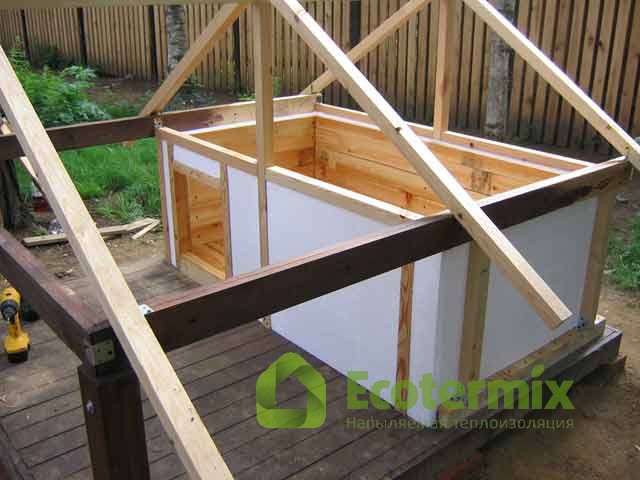
Unfortunately, the foam is too combustible - it is dangerous not only for the dog and its booth, but also for nearby buildings.
To achieve the maximum effect, all parts of the dog house are usually insulated - the floor, roof and walls. For each element, it is necessary to use different materials, based on their thermal insulation characteristics, as well as the pros and cons of a particular insulation. The main types of materials used as heaters are as follows:
We recommend regular shampoo cleaning and care. Thanks to this, it will look like new for a long time. If possible, locate the hut in a location where it will not be adversely affected by harmful atmospheres. If the barn is comfortable and placed in the right place, chances are that the dog will convince her and be more willing to spend time outside. To keep the animals in motion, we must allow him to move freely in the garden. Where and, it is worth building a podium with a dog fence that restricts access to plants in the garden.
The choice of specific materials depends on the location of the booth and the personal preferences of the owner, based on the characteristics of each of the above materials, as well as on how often the dog is in his "home".
Stages of warming a dog house
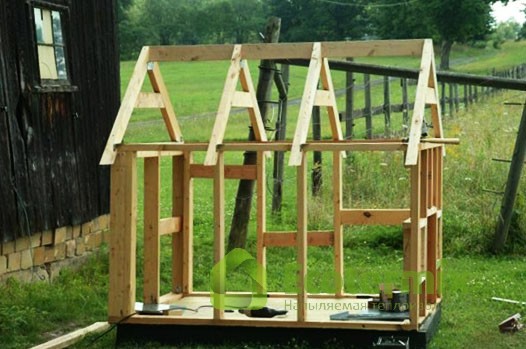
Dog barn dimensions - how to fit?
However, we must not forget that if the dog is always in a closed small area, we will have to go outside regularly. The easiest way to determine dimensions is to measure the litter the dog is in. The dimensions of the barn should be at least 20 cm larger than the results obtained. Therefore, we must - before designing the object - measure the dog from the neck to the ground. We add at least 5 cm to the resulting value. The next step is to measure the width of the dog - again add a centimeter. The height of the dog's barn should be at least a few centimeters from it.
Warming a Dog's Barn - What You Need to Know
- If we don't have one, we can measure the animal when it sleeps.
- Let's also take into account the dimensions of the entrance.
- The design of the barn should be adjusted to the size of the dog.
As a roof can be used: metal, plastic or bitumen
The first step is to ensure the thermal insulation of the booth from the inside. To do this, it is necessary to lay a layer of insulation under the outer skin of the inner space, and you can hide the material with plywood or eurolining. It is important that the inner lining is firmly attached to the insulation. At the same time, it is necessary to remember that the insulation does not protrude from under the skin. Otherwise, it will not only reduce the absorption of cold air, but may also cause health problems for the dog.
If it is only sporadic, it is enough to build a non-exhaustive object. However, if the dog spends a lot of time in the garden, we will provide better protection from the weather and increase comfort. If the dog spends a lot of time in the garden, a good shed is essential.
In addition to the standard underlayment, wall and roof insulation, special insulating mats are also recommended. These types of mats are very easy to assemble - they are fastened with Velcro. In addition, they perfectly adhere to the walls, which further improves insulation against cold and moisture.
If the ceiling of the booth has a folding top, additional insulation will be required. You can make it two- or three-layer, without the use of heat-insulating materials. As a roof can be used: metal, plastic or bitumen. However, regardless of the material chosen, each of them must have a base of solid boards, which will be the first barrier to cold air. Thus, the insulation of a dog kennel should be complex when using various materials.
How to build an insulated dog hut?
For construction, we need a drill, a saw, a meter, a crusher and a level. If you plan to additionally cover the bituminous mountain, you must also turn on the gas burner.
Step 1: Building the base of the dog barn
Let's start by building the barn base. At this point, we need to create the skeleton. Let's remember just below the plate.Step 2: Building the Wall of the Dog Barn
Don't forget to set the base size correctly - it doesn't have to match the size of the interior, but it's better to be a little big. The rest of the disc will be cut and sanded. The next step is to install a skeleton of squares on a pre-prepared base. We need.
Features of kennel insulation when using polyurethane foam
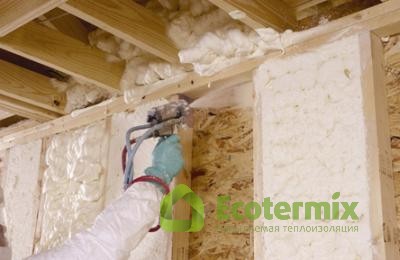
Polyurethane foam is absolutely harmless for both humans and animals, and its heat-insulating properties make it one of the best materials for warming a doghouse
Double, full board for the side panels, one full board for the back wall, one board with a cutout for the front wall entry. The next step is to insulate the styrofoam - they are mounted on a rack. The last activity is the installation of the outer walls.
Most people build a barn roof that connects directly to the framing of the walls. This is a simple and popular solution, but not necessarily practical. Access through a small hole to the inside of the barn is very difficult, so disinfection and cleaning will not be the easiest. The solution is the design of a removable roof. In this case, we can easily raise the roof, gaining access to the interior.
Currently, this material is widely used in both residential and industrial quality. This is due not only to the affordability of polyurethane foam, but also to its unique characteristics that favorably distinguish this material from a number of similar heaters. In particular, it should be noted that there are several types of it: rigid PPU and elastic PPU.
The construction phase of the roof structure is similar to the previous one. The first step is to frame the squares in the gable design. It is advisable to design the roof so that it can be connected to the walls of the barn - we will avoid moving it. If the roof is installed as a separate structure, not connected to the rest of the barn, we must. It is also important to finish the roof with shingles, which protect the structure from moisture penetration and adverse weather conditions.
Both the heating house and without it should be located in a shady place, as its interior warms up very quickly. It is best to place it under a tree or building. You also have to consider the orientation of the object's entry into the world. It is important that the correct location minimizes the impact of rain or wind. In Poland, the winds usually come from the west, so it seems preferable to place the front on the east side.
The main difference between them is moisture resistance. and pools. As a heater for the inner surface of the booth, elastic polyurethane foam should be used. This is due to the fact that it has an open structure and absorbs moisture, thereby reducing its effectiveness as a heat-insulating material when used outside. Accordingly, polyurethane foam with a rigid structure is perfect for insulating the outer side of the walls of the booth.
If the roof is installed as a separate structure, not connected to the rest of the barn, we must install special hinges that will hold the roof and protect it from the wind. Buda cannot be placed on uncovered ground! If we don't take care of it, we will quickly take the base back - and thus the rest of the barn. It is a good idea to lay a Euro pallet or a wooden frame.
Dog barn interior decoration
In the pond, you should place material that will increase your dog's comfort. We can choose mattresses, couches and similar waterproof products. In addition, the interior can be laid blankets. Unfortunately, this material quickly absorbs moisture and is difficult to keep clean. There is also straw inside the interior, but here we find many flaws. Because the straw is unstable, it releases pollen and can even lead to conjunctivitis in the dog.
In general, the insulation of the booth with polyurethane foam is the most optimal. This is due to the main characteristics of this material, which is a modified structure of plastic. And since almost all the elements that people use in everyday life are made of plastic today, polyurethane foam is as safe in terms of toxicity as, for example, mattresses or car seats. Moreover, the material purchased in large shopping centers or in specialized firms has all quality certificates and environmental safety guarantees.
Pipe door - additional insulation protection
To increase the insulation of the barn and protect it from the weather, we can install a hinged door at the entrance. Remember, however, that in the summer, remove them completely or leave them open - and protect them from overheating. A kennel is controversial for many, but if you have the right structure, size, and insulation, it can be a complementary or primary source of dog shelter. Some breeds of dogs deserve to be kept outdoors, and keeping them indoors is a real pain for them.

Polyurethane foam can be purchased both in liquid form (applied by spraying) and in solid form (slabs)
Polyurethane foam can be purchased both in liquid form (applied by spraying) and in solid form (slabs). As a rule, the plates are massive and not very suitable for warming the booth. It is best to use special liquid foam sprayers, the main advantages of which can be considered the following:
Which purchase for your quad?
The right shed eliminates the problem of cold and allows the dog to shelter from rain or frost.
- Classic building - Two storey building.
- Resin Gable Roofs - Flat Roofs.
- The liquid structure completely fills all cracks and gaps, thereby providing maximum protection against cold air.
- booths (as a rule, this is a tree) from the occurrence of mold, fungus and rot.
- After hardening, PPU increases the soundproofing of the dog kennel.
- With proper application and the absence of mechanical damage, PPU will last more than 30 years.
Unconventional ways of warming
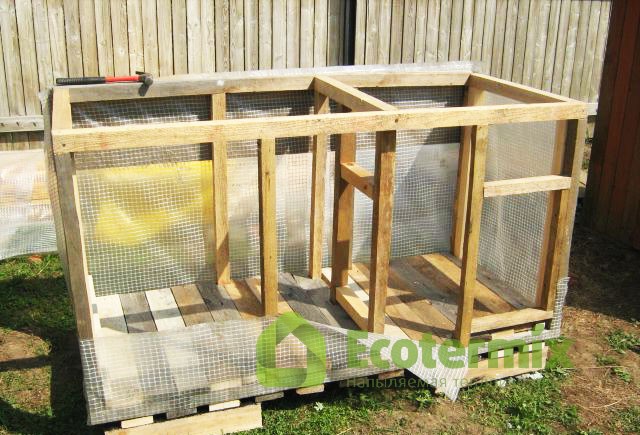
In extreme weather conditions, even a well-insulated barn may not be warm enough or poorly protected from strong sun, in which case the animal must be moved to a more comfortable location. The shelter for the dog should be comfortable, and this means that the animal should be free to enter, leave and lie in it. Therefore, the size of the barn should be measured by measuring the height of the dog at the withers and its length and width when lying down. Add a small amount of your dog to make it comfortable.
Dog types - comparison
Not only the size of the entire structure, but also the input. Too big a hole leads to cooling of the interior and too small, forcing the animal to squeeze through it. The door should be slightly lower than the dog and only slightly wider than the animal. If your dog will be outdoors not only in the summer and fall, but also in the winter, it's worth taking a look at some of the larger vestibule models. These structures resemble a small animal house - they may have a door and a window. The entrance to the stall leads to the lobby, where it turns into the right room - the size of such a stall is larger than the standard, but the dog is much warmer, because there is not so much cold air in the middle. Buda with a terrace or a terrace and a vestibule - has a closed and an open part. It takes up more space than the classic model, but is very comfortable for the dog. The double style is a top shelf option, a true home for dogs. These types of tiles are usually made to order. They can have a bottom entry and a raised bed - they are warm and impressive.
Boards for small, medium and large dogs - sample sizes
- The classic hall is a small barn with an entrance.
- The dog has one room.
- This is an economical and very popular solution.
- In cold winters, the inside of the barn can get cold.
- Buda from the hallway is an even warmer and more comfortable version of the classic shelf.
The film is installed under the casing of the booth
If, after the implementation of insulation measures, the booth still lets in cold air and the dog is uncomfortable there, you can use additional heaters. These include heaters. It is important to remember that when using them, it is necessary that the booth be protected from accidental ignition. For this purpose, only heat-resistant materials should be used as the main insulation, the most optimal of which is recognized as polyurethane foam.
The main types of heaters:
- Panel systems. They are represented by elongated metal panels located in a metal case. Thickness - no more than 2 cm, that is, it can be compactly placed in a doghouse. They are fastened with self-tapping screws to the skin.
- Film systems. This is a specially made thermal film that heats the booth using infrared radiation. It must be installed under the casing of the booth.
Thus, when answering the question of how to insulate a dog kennel, it is important to consider its location and size. Taking into account these nuances, the necessary materials are selected and, if necessary, additional measures of thermal protection in the face of heaters. You can read about the insulation of gazebos in the country on the page.
Video on how polyurethane foam is sprayed from Ecotermix:
The prices for the services of our company can be found in the section
Or order a consultation of a specialist at a convenient time for you!
Request absolutely free and does not oblige you to anything!
Pavel Bondarenko, Donetsk.
With the onset of winter, many owners of dogs living in the yard of a private house come to the conclusion that it is necessary to additionally insulate their pet's home. Of course, the booth must initially be made according to all the rules of "booth" architecture, that is, the design itself is made of good quality and warm: the walls have a heat-insulating layer, the outer upholstery eliminates the presence of cracks, and so on. The most logical action in this case is to install a curtain that would close the hole in the booth. The curtain, which is absolutely not necessary in the warm season, turns out to be most welcome in winter. So I had a need to manufacture this, at first glance, a simple product.
There are probably few experts in the matter of making doghouse curtains. So I, not being one, decided to study the issue on the example of the experience of people who have succeeded in this business more than me and posted information about their products on the Internet. As a result of searching and getting acquainted with information on the topic, I realized that most users consider the curtain a product that is very simple and does not require special attention and description. Actually, a piece of some fabric unnecessary in the household, which is nailed on top of the manhole and cut along the vertical - this is a typical design. However, in practice, everything turned out to be not so simple.
At first I decided not to come up with anything particularly unique and, having found a suitable piece of a flannelette blanket, I made a curtain of the simplest design out of it.
What this product was, I will describe a little lower, first I will give the initial data, which determined the design and size of the curtain - these are the parameters of the booth manhole.
The manhole is a rectangular hole measuring 400 (width) X 450 (height) mm in the front wall of the booth. The manhole is shifted to the left side of the front wall and is located at a distance of 65 mm from the outer edge of the left wall of the booth and 540 mm from the outer edge of the right wall of the booth. The manhole has a threshold, so the lower edge of the manhole is located at a height of 115 mm from the lower edge of the front side of the booth. Along the perimeter of the manhole there is a cashing made of a rail 20 (thickness) X 28 (width) mm. Now directly description of the design of the curtain.
A piece of a flannelette blanket measuring 530x1240 mm and about 1.5 mm thick is doubled in length. The result was a two-layer blank with a width of 530 and a length of 620 mm. Along the length of the workpiece in the center of the canvas, a cut 520 mm long is made - the entrance. The cut is made in the direction of the inflection of the workpiece tissue and does not reach the inflection, respectively, by 100 mm. The upper part of the workpiece (above the cut, in the place of the inflection of the fabric) is sandwiched between two wooden slats 60 wide and 530 mm long. The thickness of the rails is 12 mm. The curtain is fastened with 2 self-tapping screws above the upper rail of the manhole trim using two wooden linings 12 mm thick to prevent deflection of the curtain fabric when touching the upper rail of the manhole trim. It is simpler - two linings must be placed under the structure at the attachment point so that the curtain fabric hangs freely down without touching the manhole trim. That is if you have cash. In the absence of such, it is clear that nothing needs to be laid, moreover, the lower rail of the structure, adjacent directly to the wall of the booth, should be as thin as possible to prevent the appearance of a gap between the curtain and the wall of the booth. It may even make sense to exclude this rail from the design in general, but then the installation of the curtain will become more complicated and the curtain itself will lose its mobility and completeness of the structure. The height of the curtain is set in such a way that its lower edge is 50 mm below the upper edge of the manhole threshold.
I draw your attention to the fact that the material for the manufacture of curtains should be exactly a flannelette blanket or a fabric similar in parameters: on the one hand, the material is thick enough with satisfactory heat-insulating properties, on the other hand, it is soft. In this case, you can get minimal clearances around the perimeter of the curtain, even if you have a dog on a chain. By the way, when using insufficiently soft fabric and in the absence of special measures to neutralize the action of the chain, this chain greatly complicates the work of the curtain, clinging to it and partially dragging it inside the booth, thus creating gaps incompatible with satisfactory thermal insulation.
The manufacture of the above curtain took quite a bit of time. Perhaps this is the main significant advantage of this design.
The product was installed and worked well for a while. The only thing that I immediately did not like was the presence of a gap between the shutter doors. However, immediately after installation, the gap was very small and, compared with the obvious general improvement in the thermal insulation of the booth - the hole is much larger than a small gap - could be considered an insignificant trifle. However, over time, this gap gradually increased. After some time, its size already called into question the effectiveness of this design. In addition, a flannelette blanket, even folded in half, does not inspire much confidence as a heat-insulating material. There is a desire to replace it with something denser and thicker, especially in frosts from 8 -10 ° C.
Nevertheless, such a simple curtain, despite its shortcomings, performed its functions satisfactorily, and its design and parameters were used by me as a guideline in the manufacture of a more advanced curtain design. The curtain was dismantled, having honestly worked for one season. This is what the fabric used in this curtain looks like.
The gap between the doors of a simple curtain for a booth
The gap between the flaps in the picture is slightly smaller than that formed on the real curtain during one season of operation and the shape of the hole is different, but still the photo allows you to get an idea of the product, albeit an approximate one.
A more solid curtain will be described later. But is it worth it to "bother" with its manufacture - decide for yourself. The simplest curtain that I talked about is already a good solution to the problem. Yes, there are small gaps around the perimeter, the wind blows on the sides, yes there is a gap in the center, but in general the device works satisfactorily. If you want to have a better thing and you can spend a few evenings after work not talking to the TV, but tailoring, locksmithing and carpentry - read the article below. So,
High quality dog kennel
To begin with, let's decide how a high-quality curtain should differ from the previously described simple design, which, despite its shortcomings, is a quite decent basic model, on the basis of which we will create our new product.
First of all, it is necessary to eliminate the static gap between the leaves in the center of the booth manhole and minimize the possibility of the appearance and subsequent increase of this gap.
Why can this gap increase during operation? The dog constantly pushes the fabric to the sides, the fabric is wrinkled, stretched and remains deformed. If the dog is powerful and wide enough, like mine, for example, and the coat is periodically wet from rain or snow, which is inevitable, the process of deformation of the curtain passes quite quickly. As a result, instead of an inconspicuous gap, we get a hole of significant size - in my case, something about 120 mm in the widest part - resembling an inverted U in shape.
How to deal with it. First of all, the curtain should not be made from one piece of fabric cut in the middle, but from two independent pieces connected into a single structure with an overlap, an overlap. In my curtain, the overlap is 50 mm. Enough, but you can do a little more. In this case, the fabric should be sufficiently rigid, that is, if possible, it should succumb to deformation as weakly as possible.
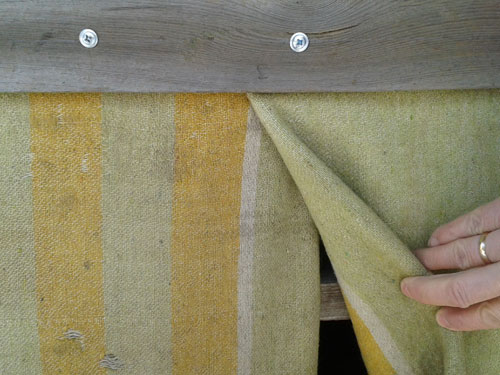
The weighting of the lower parts of the sashes has a very positive effect on reducing the gap in the center and in general on the operation of the curtain. But more on that later.
What does static clearance mean? This is the gap when closing the curtain manually, when the flaps hang down freely, without catching on the threshold of the manhole or the chain that the dog is tied to. With a chain, of course.
It is much more difficult to deal with gaps that arise directly during the normal operation of the curtain. When testing experimental samples of curtains made of various materials, it was found that it is often quite difficult to achieve a clear, high-quality closing of the manhole. The dog will not correct the stuck sash. Yes, and she breaks into the booth at different angles, from different directions and at different speeds. Again, the chain is stretched differently and pulled into the booth. All this leads to the fact that the quality of closing the curtain, that is, maintaining relatively the same and minimum gaps at each closing, strongly depends on how the dog enters the booth at one time or another.
This problem is solved in several ways, the first and simplest of which is the use of soft fabric for the manufacture of curtains, as in our basic model. Moreover, even if one or two wings are pulled into the booth by a chain or a dog, the gaps will be quite tolerable. In addition, soft shutters cannot get stuck, catching on the threshold of the booth, which easily happens with long (below the threshold) hard curtains and leads to the formation of a huge gap in the manhole zone. However, soft fabric is in most cases not the best thermal insulation and wind protection. Of course, we mean available materials - it is quite possible that you can find a soft fabric with all the necessary properties among high-tech modern products, but this is not our case.
The second way, which, in combination with the weighting of the lower edge of the shutters, allows you to achieve a clear closing of the curtain with minimal dependence on the actions of the dog and the presence of a chain, is to set it in height so that a gap of 15-20 mm is obtained between the lower edge of the curtain and the upper edge of the booth threshold . The shutter closes normally, but the presence of a significant gap calls into question the appropriateness of using this method. High-quality closing of the manhole with such a curtain device does not work - the gap cannot be called minimal. Nevertheless, I have met similar designs, however, without weighting the curtains, in practice. Even with gaps far exceeding 15-20 mm. I would characterize such an option as "better than nothing".
And finally, the third way. Separate sashes are made of dense fabric. The curtain is suspended as suggested for the second method, namely, 15-20 mm above the threshold of the booth. Four are sewn to the lower parts of the flaps - two for each flap, from the front and back sides of the flaps - flaps made of soft fabric. These valves close the gap between the threshold and the curtain.


This variant of the design of the curtains showed good quality of closing the manhole during operation with minimal dependence on the actions of the dog and the presence of a chain and was adopted as the main one for the manufacture of high-quality curtains.
The next step in finalizing the basic design will be to improve the thermal insulation and windproof properties of the product. In practice, I realized the improvement of these properties by replacing the curtain material and applying measures to eliminate side gaps.
Regarding the material, the following was done: instead of two layers of a flannelette blanket, he used four layers of woolen. The result fully met expectations - the design turned out to be solid, inspiring confidence.
Side gaps take place in the case when the curtain is attached only above the entrance to the booth, as is done in most cases in practice. In principle, in calm weather, these gaps may be absent or insignificant, but in the presence of wind, blowing into the booth is inevitable. In strong winds, due to significant fluctuations in the curtain, the entrance to the booth can periodically open almost completely. Improves the situation, but does not eliminate the problem of the weighting of the lower parts of the valves. The way to save the dog from blowing into the side cracks is very simple. The curtain is made with a certain margin in width and is nailed on the sides through a wooden lath with small nails to the wall of the booth.
Self-tapping screws can be used instead of nails. This is if the dog likes to tear off the slats between times. Well, or just for reliability.
And the last stage of refinement. A noticeable improvement in the quality of the work of the product can be achieved by applying the weighting of the lower edges of the valves. The weighting agents keep the sashes in a taut state, which contributes to a significant reduction in their deformation during operation and prevents the appearance of a gap between the sashes. The clarity of the manhole closing increases due to the increase in the closing speed and, as a result, the tendency of the leaves to catch on an obstacle, for example, a chain, and “hang” on it, leaving part of the manhole open, decreases. In fact, weighting leads to a noticeable decrease in the dependence of the curtain on how the dog entered or left the booth at the moment. However, as for the exit from the booth, the weighted curtains close in this case almost always equally well.
Structurally, the weighting agent is a set of steel plates 28x28x2 mm in size, sewn into the sash along that part of its lower edge, which is opposite the manhole. A set of plates, rather than a single steel strip or rod, is used to keep the sash flexible, which has a positive effect on the quality of the blind as a whole.
The photo shows the lower edge of the right sash with weights sewn in.

So, by deep modification of the basic curtain model, we got a product of the following design (the dimensions are indicated for the booth, the parameters of which are described in the first part of the article).
Two flaps measuring 675 (height) X 490 (width) mm are made of a woolen blanket. The sashes are four-layer, which provides good thermal insulation.
Each sash has two flaps in the lower part made of a bike measuring 270x140x1.5 mm.
Each sash has weights in the lower part from a set of steel plates 28x28x2 mm - 6 pcs. on each sash.
The sashes have a mutual overlap in width equal to 50 mm in the middle of the curtain.
The upper edges of the sashes are located on the same line and are clamped with three self-tapping screws between two wooden slats measuring 530x60x12 mm so that the center of the curtain web - two sashes folded overlapping - coincides with the centers of the slats.
This design is mounted above the manhole so that the center of the curtain coincides with the center of the manhole, and the distance between the lower edge of the curtain part made of woolen material and the upper edge of the booth threshold is 15-20 mm. That is, the height adjustment of the installation is carried out with the bike valves raised up.
Between the lower mounting rail and the front wall of the booth there is an adjusting rail 12 mm thick to eliminate the grazing of the curtain by cashing the manhole.
The structure is attached to the wall of the booth with two self-tapping screws, the length of which, as far as I remember, is 70 mm.
The outer vertical sides of the curtain and the horizontal parts of the upper edge, which are not clamped by fastening strips, are nailed to the booth wall with nails 20 mm long through a strip of plywood 4 mm thick and 20-25 mm wide.
The result is a design similar to the one shown in the photo:
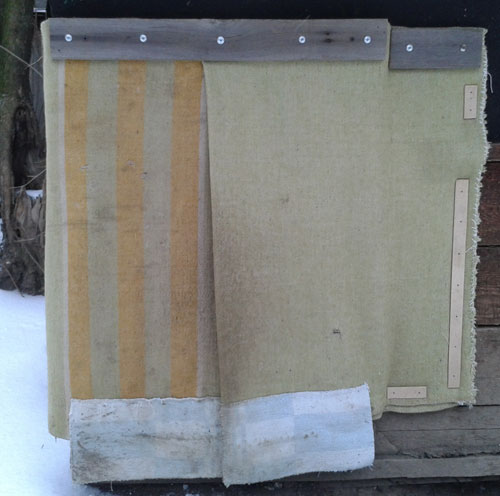
Here are the product specifications:
1. good thermal insulation and wind protection (windproof curtain fabric, no gaps on the sides and top of the manhole);
2. closing the manhole while maintaining minimal gaps in the center and at the bottom of the manhole even when the dog is on a chain;
3. the minimum cost of the product, the availability of materials and tools.
Here is a description of some of the characteristic moments of making a curtain.
The process of manufacturing blanks for shutter doors from a blanket of a standard size of 1400x2050 mm looks like this.
The blanket is cut in half lengthwise. Then each of the resulting parts 1400x1025 is folded in half along the length. We get two parts 1025x700. Then these parts are folded in half lengthwise. We get two blanks with a size of 512.5x700 mm. This is the case if the blanket is new and exactly corresponds to the standard sizes. In my case, the blanket probably noticeably "settled" over its rather long life, so the final blanks had a size of 675x490, which is unprincipled.
One of the long sides of each piece is the fold side of the fabric. These sides will be the inner sides of the sashes. One of the short sides of each blank is two sections of fabric folded together. These sides will be the top side of each sash. The outer vertical sides of the sashes should be overcast.
Blankets for flannelette valves should be overcast around the perimeter. The valves are sewn to the sashes after the weighting plates are sewn in. The valve is sewn to the leaf with only one horizontal seam located at a distance of 5-7 mm from the upper edge of the valve. The distance from the lower edge of the "woolen" part of the leaf to the lower edge of the damper is 75 mm.
The curtain mounting rails have two (lower rail) and five (upper rail) mounting holes. When using self-tapping screws with a diameter of 4 mm, the diameter of all holes is 4.5-5 mm.
There are only holes No. 1 and 5 in the bottom rail. They are used to fasten the entire assembly to the wall of the booth. It is advisable to drill these holes after the blind is clamped between the slats with screws no. 2, 3 and 4. Screw no. 3 connects the mounting rails exactly in the center. It must pass through the center of the sash overlap.
This design performed well. However, after two months of operation, there was also a reason for a little refinement. The woolen fabric of the shutters has slightly stretched vertically and the gap between the "woolen" part of the curtain and the threshold has noticeably decreased. If the gap disappears completely, the shutter will not operate normally. Therefore, for the next season, I will strengthen the sashes by sewing strips of dense braid on the inside.
Pavel Bondarenko, Donetsk.
Other questions on the topic of kennels and booths for dogs:
Wooden barrel as a dog house
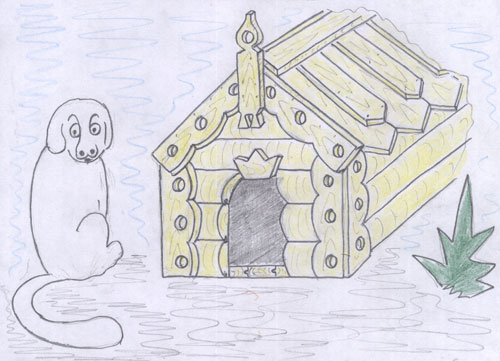
Ask a question to Semenych (the author of the materials)
Our site is regularly updated with interesting and unique materials and articles on the topic of lumber, building materials and works, the author's opinion and knowledge of a real coven worker with more than 15 years of experience is given. There is a section - funny stories of covenants. If you would like to receive information about this, subscribe to our site's newsletter. We guarantee that your address will not be passed on to third parties.
